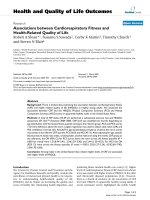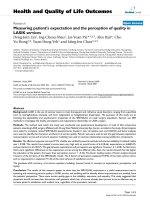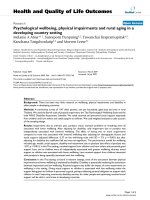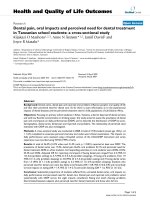Báo cáo hóa học: " Approximately cubic functional equations and cubic multipliers" pdf
Bạn đang xem bản rút gọn của tài liệu. Xem và tải ngay bản đầy đủ của tài liệu tại đây (271.82 KB, 8 trang )
RESEARCH Open Access
Approximately cubic functional equations and
cubic multipliers
Abasalt Bodaghi
1*
, Idham Arif Alias
2
and Mohammad Hossein Ghahramani
1
* Correspondence: abasalt.
1
Department of Mathematics,
Garmsar Branch, Islamic Azad
University, Garmsar, Iran
Full list of author information is
available at the end of the article
Abstract
In this paper, we prove the Hyers-Ulam stability and the superstability for cubic
functional equation by using the fixed point alternative theorem. As a consequence,
we show that the cubic multipliers are supe rstable under some conditions.
2000 Mathematics Subject Classification: 39B82; 39B52.
Keywords: cubic functional equation, multiplier, Hyers-Ulam stability, Superstability
1. Introduction
The stability problem for functional equations is related to the following question origi-
nated by Ulam [1] in 1940, concerning the stability of group h omomorphisms: Let ( G
1
,
.) be a group and let (G
2
, *) be a metric group w ith the metric d(., .). Given ε >0, does
there exist δ >0 such that, if a mapping h : G
1
® G
2
satisfies the inequality d(h(x.y), h(x)
* h(y)) < δ for all x, y Î G
1
, then there exists a homomorphism H : G
1
® G
2
with d(h(x),
H(x)) < ε for all x Î G
1
?
In 1941, Hyers [2] gave a first affirmative answer to the question of Ulam for Banach
spaces. Later, Rassias in [3] provided a remarkable genera lization of the Hyers’ result
by allowing the Cauchy difference to be bounded for the first time, in the subject of
functional equations and inequalities. Gǎvruta then generalized the Rassias’ result in
[4] for the unbounded Cauchy difference.
The functional equation
f
(
x + y
)
+ f
(
x − y
)
=2f
(
x
)
+2f
(
y
)
(1:1)
is called quadra tic functional equat ion. Also, every solution (for example f(x)=ax
2
)
of functional Equation (1.1) is said to be a quadratic mapping. A Hyers-Ulam stability
problem for the quadratic functional equation was proved by Skof [5] for mappings
f
: X →
Y
,where
X
is a normed space and
Y
is a Banach space. Cholewa [6] noticed
that the theorem of Skof is still true if the relevant domain
X
is replaced by an abelian
group. In [7] Czerwik proved the Hyers-Ulam-Rassi as stability of the quadratic func-
tional equation. Several functional equations have been extensively investigated by a
number of authors (for instances, [8-10]).
Jun and Kim [11] introduced the functional equation
f
(
2x + y
)
+ f
(
2x − y
)
=2f
(
x + y
)
+2f
(
x − y
)
+12f
(
x
)
(1:2)
Bodaghi et al. Journal of Inequalities and Applications 2011, 2011:53
/>© 2011 Bodaghi et al; licensee Springer. Th is is an Open Access article distributed under the terms of the Creative Commons
Attribution License ( which permi ts unrestricted use, distribution, and reproduction in
any medium, provided the original work is properly cited.
which is somewhat different from (1.1). It is easy to see that function f(x)=ax
3
is a
solution of (1.2). Thus, it is natural that Equation (1.2) is called a cubic functional
equation and every solution of this cubic functional equation is said to be a cubic func-
tion. One year after that, they solved the generalized Hyers-Ulam-Rassias stability of a
cubic functional equ ation f(x +2y)+f(x-2y)+6f(x)=f(x + y )+4f(x-y) in Jun and
Kim [12]. Since then, a number of authors (for details see [13,14]) proved the stability
problems for cubic functional equation.
Recently, Bodaghi et al i n [15] proved the superstability of quadratic double centrali-
zers and of quadratic multipliers on Banach algebras by fixed point methods. Also, the
stability and the superstability of cubic double centralizers of Banach algebras which
are strongly without order had been established in Eshaghi Gordji et al. [16].
In this paper, we remove the condition strongly without order and investigate the
generalized Hyers-Ulam-Rassias stability and the superstability by using t he alternative
fixed point for cubic functional Equation (1.2) and their correspondent cubic
multipliers.
2. Stability of cubic function equations
Throughout this section, X is a normed vector space and Y is a Banach space. For the
given mapping f : X ® Y , we consider
Df
(
x, y
)
:= f
(
2x + y
)
+ f
(
2x − y
)
− 2f
(
x + y
)
− 2f
(
x − y
)
− 12f
(
x
)
for all x, y Î X.
We need the following known fixed point theorem, which is useful for our goals (an
extension of the result was given in Turinici [17]).
Theorem 2.1. (The fixed point al ternati ve [18]) Suppose that (Ω, d) a complete gen-
eralized metric space and let
J
: →
be a strictly contractive mapping with
Lipschitz constant L < 1. Then for each element x Î Ω, either
d
(
J
n
x, J
n+1
x
)
=
∞
for all
n ≥ 0, or there exists a natural number n
0
such that:
(i)
d
(
J
n
x, J
n+
1
x
)
<
∞
for all n ≥ n
0
;
(ii) the sequence
{
J
n
x
}
is convergent to a fixed point y* of
J
;
(iii) y* is the unique fixed point of
J
in the set
= {y ∈ : d
(
J
n
0
x, y
)
< ∞}
;
(iv)
d(y, y
∗
) ≤
1
1
−
L
d(y, J y
)
for all y Î Λ.
Theorem 2.2. Let f : X ® Y be a mapping wi th f(0) = 0, and let ψ : X×X® [0, ∞)
be a function satisfying
lim
n→∞
ψ(2
n
x,2
n
y)
8
n
=
0
(2:1)
and
|
|Df
(
x, y
)
|| ≤ ψ
(
x, y
)
(2:2)
Bodaghi et al. Journal of Inequalities and Applications 2011, 2011:53
/>Page 2 of 8
for all x, y Î X. If there exists L Î (0, 1) such that
ψ
(
2x,0
)
≤ 8Lψ
(
x,0
)
(2:3)
for all x Î X, then there exists a unique cubic mapping C : X ® Y such that
|
|f (x) − C(x)|| ≤
L
2
(
1 − L
)
ψ(x,0
)
(2:4)
for all x Î X.
Proof: We consider the set Ω := {g : X ® Y|g(0) = 0} and introduce the generalized
metric on Ω as follows:
d
(
g
1
, g
2
)
:= inf{C ∈
(
0, ∞
)
: ||g
1
(
x
)
− g
2
(
x
)
|| ≤ Cψ
(
x,0
)
for all x ∈ X
}
if there exists such constant C,andd(g
1
, g
2
)=∞, otherwise. One can prove that t he
metric space (Ω, d) is complete. Now, we define the mapping
J
: →
by
J g(x)=
1
8
g(2x), (x ∈ X)
.
If g
1
, g
2
Î Ω such that d(g
1
, g
2
) <C, by definition of d and
J
, we have
1
8
g
1
(2x) −
1
8
g
2
(2x)
≤
1
8
Cψ(2x,0
)
for all x Î X. By using (2.3), we get
1
8
g
1
(2x) −
1
8
g
2
(2x)
≤ CLψ(x,0
)
for all x Î X. The above inequality shows t hat
d
(
J g
1
, J g
2
)
≤ Ld
(
g
1
, g
2
)
for all g
1
, g
2
Î Ω.Hence,
J
is a strictly contr active mapping on Ω with Lipschitz constant L.Put-
ting y = 0 in (2.2), using (2.3), and dividing both sides of the resulting inequality by 16,
we have
1
8
f (2x) − f(x)
≤
1
16
ψ(x,0)≤
1
2
Lψ
x
2
,0
for all x Î X.Thus,
d(f , J f ) ≤
L
2
<
∞
. By Theorem 2.1, the sequence
{J
n
f }
con-
verges to a fixed point C : X ® Y in the set Ω
1
={g Î Ω; d(f, g) <∞}, that is
C(x) = lim
n→∞
f (2
n
x)
8
n
(2:5)
for all x Î X. By Theorem 2.1, we have
d(f , C) ≤
d(f ,
J f )
1 − L
≤
L
2
(
1 − L
)
.
(2:6)
Itfollowsfrom(2.6)that(2.4)holdsforallx Î X. Substituting x, y by 2
n
x,2
n
y in
(2.2), respectively, and applying (2.1) and (2.5), we have
|
|DC(x, y)|| = lim
n→∞
1
8
n
||Df(2
n
x,2
n
y)||
≤ lim
n→∞
1
8
n
ψ(2
n
x,2
n
y)=
0
Bodaghi et al. Journal of Inequalities and Applications 2011, 2011:53
/>Page 3 of 8
for all x Î X. Therefore C is a cubic mapping, which is unique. □
Corollary 2.3. Let p and l be non-negat ive real numbers such that p <3. Suppose
that f : X ® Y is a mapping satisfying
||Df
(
x, y
)
|| ≤ λ
(
||x||
p
+ ||y||
p
)
(2:7)
for all x, y Î X. Then, there exists a unique cubic mapping C : X ® Y such that
|
|f (x) − C(x)|| ≤
2
p
λ
2
(
8 − 2
p
)
||x||
p
(2:8)
for all x Î X.
Proof: The result follows from Theorem 2.2 by using ψ(x, y)=l(||x||
p
+||y||
p
). □
Now, we establish the superstability of cubic mapping on Banach spaces.
Corollary 2.4. Let p, q, l be non-negative real numbers s uch that p, q Î (3, ∞).
Suppose a mapping f : X ® Y satisfies
|
|Df
(
x, y
)
|| ≤ λ||x||
q
||y||
p
(2:9)
for all x, y Î X. Then, f is a cubic mapping on X.
Proof: Letting x = y = 0 in (2.9), we get f(0) = 0. Once more, if we put x = 0 in (2.9),
we have f(2x)=8f(x) for all x Î X. It is easy to see that by induction, we have f(2
n
x)=
8
n
f(x), and so
f (x)=
f (2
n
x)
8
n
for all x Î X and n Î N. Now, it follows from Theorem
2.2 that f is a cubic mapping. □
Note that in Corollary 2.4, if p + q Î (0, 3) and p>0 such that the inequality (2.9)
holds, then by applying ψ(x, y )=l||x||
p
||y||
q
in Theorem 2.2, f is again a cubic
mapping.
Theorem 2.5. Let f : X ® Y be a mapping wi th f(0) = 0, and let ψ : X×X® [0, ∞)
be a function satisfying
lim
n→∞
8
n
ψ
x
2
n
,
y
2
n
=
0
(2:10)
and
|
|Df
(
x, y
)
|| ≤ ψ
(
x, y
)
(2:11)
for all x, y Î X. If there exists L Î (0, 1) such that
ψ(x,0)≤
1
8
Lψ(2x,0
)
(2:12)
for all x Î X, then there exists a unique cubic mapping C : X ® Y such that
||f (x) − C(x)|| ≤
L
16
(
1 − L
)
ψ(x,0
)
(2:13)
for all x Î X.
Proof: We consider the set Ω := {g : X ® Y|g(0) = 0} and introduce the generalized
metric on Ω:
d
(
g
1
, g
2
)
:= inf{C ∈
(
0, ∞
)
: ||g
1
(
x
)
− g
2
(
x
)
|| ≤ Cψ
(
x,0
)
∀x ∈ X
}
if there exists s uch constant C,andd( g
1
, g
2
)=∞,otherwise.Itiseasytoshowthat
(Ω, d) is complete. We will show that the mapping
J
: →
defined by
Bodaghi et al. Journal of Inequalities and Applications 2011, 2011:53
/>Page 4 of 8
J g(x)=8g
x
2
;(x Î X) is strictly contractive. For given g
1
, g
2
Î Ω such that d(g
1
, g
2
)
<C, we have
8g
1
x
2
− 8g
2
(
x
2
)
≤
1
8
Cψ(2x,0
)
for all x Î X. By using (2.12), we obtain
8g
1
x
2
− 8g
2
x
2
≤ CLψ ( x ,0
)
for all x Î X. It follows from the last inequality that
d
(
J g
1
, J g
2
)
≤ Ld
(
g
1
, g
2
)
for all
g
1
, g
2
Î Ω.Hence,
J
is a strictly co ntractive mapping on Ω with Lipschitz constant L.
By putting y = 0 and replacing x by
x
2
in (2 .11) and using (2.12), then by dividing both
sides of the resulting inequality by 2, we have
8f (
x
2
) − f (x)
≤
1
2
ψ
x
2
,0
≤
1
1
6
Lψ(x,0
)
for all x Î X. Hence,
d(f , J f ) ≤
L
1
6
<
∞
. By applying the fixed point alternative,
there exists a unique mapping C : X ® Y in the set Ω
1
={g Î Ω; d(f, g) <∞} such that
C(x) = lim
n→∞
8
n
f
x
2
n
(2:14)
for all x Î X. Again, Theorem 2.1 shows that
d(f , C) ≤
d(
f
, J
f
)
1 − L
≤
L
16
(
1 − L
)
(2:15)
where the inequality (2.15) implies the relation (2.13). Replacing x, y by 2
n
x,2
n
y in
(2.11), respectively, and using (2.10) and (2.14), we conclude
||DC(x, y)|| = lim
n→∞
8
n
Df
x
2
n
,
y
2
n
≤ lim
n→∞
8
n
ψ
x
2
n
,
y
2
n
=
0
for all x Î X. Therefore C is a cubic mapping. □
Corollary 2.6. Let p and l be non-negat ive real numbers such that p >3. Suppose
that f : X ® Y is a mapping satisfying
|
|Df
(
x, y
)
|| ≤ λ
(
||x||
p
+ ||y||
p
)
for all x, y Î X. Then there exists a unique cubic mapping C : X ® Y such that
|
|f (x) − C(x)|| ≤
λ
2
(
2
p
− 8
)
||x||
p
for all x Î X.
Proof: It is enough to let ψ(x, y)=l(||x ||
p
+||y||
p
) in Theorem 2.5. □
Corollary 2.7. Let p, q, l be non-negative real numbers such that p + q Î (0, 3) and
p>0. Suppose a mapping f : X ® Y satisfies
|
|Df
(
x, y
)
|| ≤ λ||x||
q
||y||
p
(2:16)
Bodaghi et al. Journal of Inequalities and Applications 2011, 2011:53
/>Page 5 of 8
for all x, y Î X. Then, f is a cubic mapping on X.
Proof: If we put x = y = 0 in (2.16), we get f(0) = 0. Again, putting x = 0 in (2.16),
we conclude that
f (x)=8f
x
2
,andthus
f (x)=8
n
f
x
2
n
for all x Î X and n Î N.
Now, we can obtain the desired result by Theorem 2.5. □
One should remember that if a mapping f : X ® Y satisfies the inequality (2.16), where
p, q, l be non-negative real numbers such that p + q>3 and p>0, then it is obvious that
f is a cubic mapping on X by putting ψ(x, y)=l||x||
p
||y||
q
in Theorem 2.5.
3. Stability of cubic multip liers
In this section, we investigate the Hyers-Ulam stability and the s uperstability of cubic
multipliers.
Definition 3.1. A cubic multiplier on an algebra A is a cubic mapping T : A ® A
such that aT(b)=T(a)b for all a, b Î A.
The following example introduces a cubic multiplier on Banach algebras.
Example.Let(A,||·||) be a Banach algebra. Then, we take B = A×A×A×A×A×A=
A
6
.Leta =(a
1
, a
2
, a
3
, a
4
, a
5
, a
6
) be an arbitrary m ember of B where we define
|||a|| | =
6
i
=1
||a
i
|
|
.Itiseasytosee(B, |||·|||)) is a Banach space. For two elements a =
(a
1
, a
2
, a
3
, a
4
, a
5
, a
6
)andb =(b
1
, b
2
, b
3
, b
4
, b
5
, b
6
)ofB, we define ab =(0,a
1
b
4
, a
1
b
5
+
a
2
b
6
,0,a
4
b
6
, 0). It is easy to show that B is a Banach algebra. We define T : B ® B by T
(a)=a
3
for all a Î B. It is shown in Eshaghi Gordji et al. [16] that T is a cubic multiplier
on A.
Theorem 3.2. Let f : A ® A be a mapping with f(0) = 0 an d let ψ: A
4
® [0, ∞) be a
function such that
|
|Df
(
x, y
)
+ f
(
z
)
w − zf
(
w
)
|| ≤ ψ
(
x, y, z, w
)
(3:1)
for all x, y, z, w Î A. If there exists a constant L Î (0, 1) such that
ψ
(
2x,2y,2z,2w
)
≤ 8Lψ
(
x, y, z, w
)
(3:2)
for all x, y, z, w Î A, then there exists a unique cubic multiplier T on A satisfying
|
|f (x) − T(x)|| ≤
L
2
(
1 − L
)
ψ(x, x,0,0
)
(3:3)
for all x Î A.
Proof. It follows from the relation (3.2) that
lim
n→∞
ψ(2
n
x,2
n
y,2
n
z,2
n
w)
8
n
=
0
(3:4)
for all x, y, z, w Î A.
Putting y = z = w = 0 in (3.1), we obtain
|
|2f
(
2x
)
− 16f
(
x
)
|| ≤ ψ
(
x, 0,0,0
)
for all x Î A. Thus,
1
8
f (2x) − f (x)
≤
1
16
ψ(x, 0,0,0
)
(3:5)
for all x Î A.
Bodaghi et al. Journal of Inequalities and Applications 2011, 2011:53
/>Page 6 of 8
Now, similar to t he proof of theorems in previous section, we consider t he set X :=
{h : A ® A|h(0) = 0} and introduce the generalized metric on X as:
d
(
h
1
, h
2
)
:= inf{C ∈ R
+
: ||h
1
(
x
)
− h
2
(
x
)
|| ≤ Cψ
(
x,0,0,0
)
for all x ∈ A
}
if there exists such constant C, and d(h
1
, h
2
)=∞, otherwise. The metric space (X, d)
is complete, and by the same reasoning as in the proof of Theorem 2.2, the mapping
F: X ® X defined by
(h)(x)=
1
8
h(2x
)
;(x Î A) is strictly co ntractive on X and has a
unique fixed point T such that
lim
n→∞
d
(
n
f , T
)
=
0
, i.e.,
T(x) = lim
n→∞
f (2
n
x)
8
n
(3:6)
for all x Î A. By Theorem 2.1, we have
d(f , T) ≤
d(
f
,
f
)
1 − L
≤
L
2
(
1 − L
)
.
(3:7)
The proof of Theorem 2.2 shows that T is a cubic mapping. If we substitute z and w
by 2
n
z and 2
n
w in (3.1), respectively, and put x = y = 0 and we divide the both sides of
the obtained inequality by 2
4n
, we get
z
f (2
n
w)
8
n
−
f (2
n
z)
8
n
w
≤
ψ(0,0,2
n
z,2
n
w)
2
4n
.
Passing to the limit as n ® ∞ and from (3.4), we conclude that zT(w)=T(z )w for all
z, w Î A. □
Corollary 3.3. Let r, θ be non-negative real numbers with r <3 and let f : A ® Abea
mapping with f(0) = 0 such that
|
|Df
(
x, y
)
+ f
(
z
)
w − zf
(
w
)
|| ≤ θ
(
||x||
r
+ ||y||
r
+ ||z||
r
+ ||w||
r
)
for all x, y, z, w Î A. Then, there exists a unique cubic multiplier T on A satisfying
|
|f (x) − T(x)|| ≤
2
r−1
θ
8
− 2
r
||x||
r
for all x Î A.
Proof. The proof follows from Theorem 3.2 by taking
ψ
(
x, y, z, w
)
= θ
(
||x||
r
+ ||y||
r
+ ||z||
r
+ ||w||
r
)
for all x, y, z, w Î A. □
Now, we have the following result for the superstability of cubic multipliers.
Corol lary 3.4. Let r
j
(1 ≤ j ≤ 4) . θ be non-nega tive real numbers with
4
j
=1
r
j
<
3
and
let f : A ® A be a mapping with f (0) = 0 such that
|
|Df
(
x, y
)
+ f
(
z
)
w − zf
(
w
)
|| ≤ θ
(
||x||
r
1
||y||
r
2
||z||
r
3
||w||
r
4
)
for all x, y, z, w Î A. Then, f is a cubic multiplier on A.
Proof. It is enough to let
ψ
(
x, y, z, w
)
= θ
(
||x||
r
1
||y||
r
2
||z||
r
3
||w||
r
4
)
in Theorem 3.2. □
Acknowledgements
The authors sincerely thank the anonymous reviewer for his careful reading, constructive comments and fruitful
suggestions to improve the quality of the manuscript. The first and third author would like to thank Islamic Azad
University of Garmsar for financial support.
Bodaghi et al. Journal of Inequalities and Applications 2011, 2011:53
/>Page 7 of 8
Competing interests
The authors declare that they have no competing interests.
Authors’ contributions
The work presented here was carried out in collaboration between all authors. AB suggested to write the current
paper. All authors read and approved the final manuscript.
Author details
1
Department of Mathematics, Garmsar Branch, Islamic Azad University, Garmsar, Iran
2
Institute for Mathematical
Research, University Putra Malaysia, 43400 Upm, Serdang, Selangor Darul Ehsan, Malaysia
Received: 21 March 2011 Accepted: 13 September 2011 Published: 13 September 2011
References
1. Ulam, SM: Problems in Modern Mathematics. Wiley, New York, sciencechapt. VI (1940)
2. Hyers, DH: On the stability of the linear functional equation. Proc Natl Acad Sci. 27, 222–224 (1941). doi:10.1073/
pnas.27.4.222
3. Rassias, ThM: On the stability of the linear mapping in Banach spaces. Proc Am Math Soc. 72, 297–300 (1978).
doi:10.1090/S0002-9939-1978-0507327-1
4. Gǎvruta, P: A generalization of the Hyers-Ulam-Rassias stability of approximately additive mappings. J Math Anal Appl
184, 431–436 (1994). MR1281518 (95e:47089). doi:10.1006/jmaa.1994.1211
5. Skof, F: Propriet locali e approssimazione di operatori. Rend Sem Math Fis Milano. 53, 113–129 (1983). doi:10.1007/
BF02924890
6. Cholewa, PW: Remarks on the stability of functional equations. Aequ Math. 27,76–86 (1984). doi:10.1007/BF02192660
7. Czerwik, S: On the stability of the quadratic mapping in normed spaces. Abh Math Sem Univ Hamburg 62,59–64
(1992). MR1182841 (94e:39026). doi:10.1007/BF02941618
8. Eshaghi Gordji, M, Bodaghi, A: On the Hyers-Ulam-Rasias stability problem for quadratic functional equations. East
Journal of Approximations. 16(2), 123–130 (2010)
9. Eshaghi Gordji, M, Bodaghi, A: On the stability of quadratic double centralizers on Banach algebras. J Comput Anal
Appl. 13(4), 724–729 (2011)
10. Lee, J, An, J, Park, C: On the stability of qudratic functional equations. Abstr Appl Anal. 2008,1–9 (2008)
11. Jun, KW, Kim, HM: The generalized Hyers-Ulam-Rassias stability of a cubic functional equation. J Math Anal Appl. 274,
867–878 (2002). doi:10.1016/S0022-247X(02)00415-8
12. Jun, KW, Kim, HM: On the Hyers-Ulam-Rassias stability of a general cubic functional equation. Math Inequal Appl. 6(2),
289–302 (2003)
13. Chang, IS, Jun, KW, Jung, YS: The modified Hyers-Ulam-Rassias stability of a cubic type functional equation. Math
Inequal Appl. 8(4), 675–683 (2005)
14. Najati, A: The generalized Hyers-Ulam-Rassias stability of a cubic functional equation. Turk J Math. 31, 395–408 (2007)
15. Bodaghi, A, Alias, IA, Eshaghi Gordji, M: On the stability of quadratic double centralizers and quadratic multipliers: a
fixed point approach. J Inequal Appl. 2011(Article ID 957541), 9 (2011)
16. Eshaghi Gordji, M, Shams, S, Ramezani, M, Ebadian, A: Approximately cubic double centralizers. Nonlinear Func Anal
Appl. 15(3), 503–512 (2010)
17. Turinici, M: Sequentially iterative processes and applications to Volterra functional equations. Ann Univ Mariae-Curie
Sklodowska (Sect A). 32, 127–134 (1978)
18. Diaz, JB, Margolis, B: A fixed point theorem of the alternative for contractions on a generalized complete metric space.
Bull Am Math Soc. 74, 305–309 (1968). doi:10.1090/S0002-9904-1968-11933-0
doi:10.1186/1029-242X-2011-53
Cite this article as: Bodaghi et al.: Approximately cubic functional equations and cubic multipliers. Journal of
Inequalities and Applications 2011 2011:53.
Submit your manuscript to a
journal and benefi t from:
7 Convenient online submission
7 Rigorous peer review
7 Immediate publication on acceptance
7 Open access: articles freely available online
7 High visibility within the fi eld
7 Retaining the copyright to your article
Submit your next manuscript at 7 springeropen.com
Bodaghi et al. Journal of Inequalities and Applications 2011, 2011:53
/>Page 8 of 8









